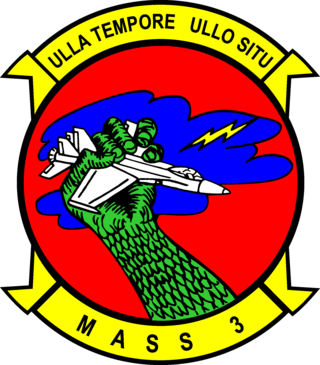
Marine Air Support Squadron 3 (MASS-3), is a United States Marine Corps aviation command and control unit that provides the Direct Air Support Center (DASC) for the 1st Marine Expeditionary Force. They are based out of the 32 Area on Marine Corps Base Camp Pendleton, California and fall under the command of Marine Air Control Group 38 and the 3rd Marine Aircraft Wing.

Marine Air Support Squadron 2 (MASS-2), is a United States Marine Corps aviation command and control unit that provides the Direct Air Support Center (DASC) for the III Marine Expeditionary Force. It is the oldest and most decorated aviation command and control unit in the Marine Corps.

Marine Air Support Squadron 1 (MASS-1) is a United States Marine Corps aviation command and control unit that provides the Direct Air Support Center to coordinate close air support for the II Marine Expeditionary Force. Callsign "Chieftain," the squadron is based out of Marine Corps Air Station Cherry Point, North Carolina, and falls under the command of Marine Air Control Group 28 and the 2nd Marine Aircraft Wing.

Marine Air Support Squadron 6 (MASS-6), is a reserve United States Marine Corps aviation command and control unit that provides the Direct Air Support Center (DASC) for the Marine Forces Reserve. Their headquarters is in Westover Air Reserve Base, Massachusetts and their Detachment Alpha is located at Marine Corps Air Station Miramar, California

Marine Air Control Group 28 (MACG-28) is a United States Marine Corps aviation command and control unit based at Marine Corps Air Station Cherry Point that is currently composed of four command and control squadrons and a low altitude air defense battalion that provide the 2nd Marine Aircraft Wing with airspace coordination, air control, immediate air support, fires integration, air traffic control (ATC), radar surveillance, aviation combat element (ACE) communications support, and an integrated ACE command post in support of the II Marine Expeditionary Force.
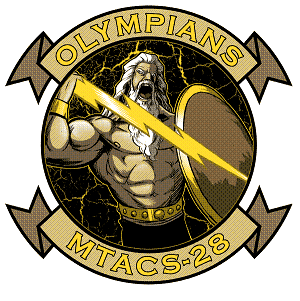
Marine Tactical Air Command Squadron 28 (MTACS-28) was a United States Marine Corps aviation command and control unit based at Marine Corps Air Station Cherry Point. They provided the 2nd Marine Aircraft Wings tactical headquarters and commanded other units within Marine Air Control Group 28. The unit was deactivated on 18 November 2022 as part of reshaping the United States Marine Corps.
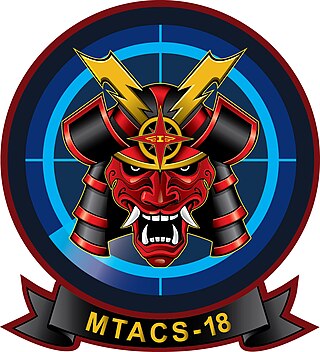
Marine Tactical Air Command Squadron 18 (MTACS-18) was a United States Marine Corps aviation command and control unit based at Marine Corps Air Station Futenma. The squadron provided the 1st Marine Aircraft Wings tactical headquarters and command post while deployed. MTACS-18 fell under the command of Marine Air Control Group 18 (MACG-18) and 1st MAW. The squadron was decommissioned on 9 June 2021 as part of the service's Force Design 2030. Responsibility for establishing 1st MAW's TACC now resides with the MACG-18 headquarters.

Marine Wing Communications Squadron 18 (MWCS-18) is a United States Marine Corps communications squadron. The squadron provides expeditionary communications for the aviation combat element of the III Marine Expeditionary Force. They are based at MCB Camp Foster and fall under the command of Marine Air Control Group 18 and the 1st Marine Aircraft Wing. Although a subordinate squadron of MACG-18, MWCS-18 is considered a 1st MAW asset and therefore serves to augment the entire 1st Marine Air Wing with communications support.

The United States Marine Corps is organized within the Department of the Navy, which is led by the Secretary of the Navy (SECNAV). The most senior Marine commissioned officer is the Commandant of the Marine Corps, responsible for organizing, recruiting, training, and equipping the Marine Corps so that it is ready for operation under the command of the unified combatant commanders. The Marine Corps is organized into four principal subdivisions: Headquarters Marine Corps, the Operating Forces, the Supporting Establishment, and the Marine Forces Reserve.

Operation Niagara was a U.S. Seventh Air Force close air support campaign carried out from January through March 1968, during the Vietnam War. Its purpose was to serve as an aerial umbrella for the defense of the U.S. Marine Corps Khe Sanh Combat Base on the Khe Sanh Plateau, in western Quang Tri Province of the Republic of Vietnam. The base was under siege by an estimated three-divisional force of the People's Army of Vietnam (PAVN).
In the United States Marine Corps, the aviation combat element or air combat element (ACE) is the aviation component of the Marine Air-Ground Task Force (MAGTF). The ACE is task organized to perform the six functions of Marine Corps aviation in support of MAGTF operations. The ACE is led by an aviation headquarters which employs rotary-wing, tiltrotor, and fixed-wing aircraft in conjunction with command and control, maintenance and engineering units.
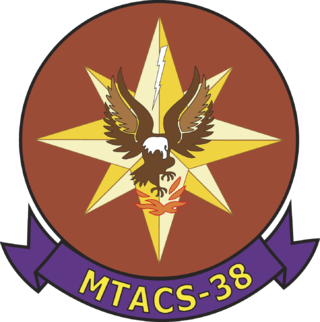
Marine Tactical Air Command Squadron 38 (MTACS-38) was a United States Marine Corps aviation command and control unit that provided the Tactical Air Command Center (TACC) for the 3rd Marine Aircraft Wing. The TACC is the senior agency in the Marine Air Command and Control System (MACCS) and serves as the operational command post for the commander of the aviation combat element and their staff. The squadron was based at Marine Corps Air Station Miramar, California and fell under the command of Marine Air Control Group 38 and the 3rd Marine Aircraft Wing.

Marine Tactical Air Command Squadron 48 (MTACS-48) is a reserve aviation command and control unit of the United States Marine Corps based at Naval Station Great Lakes, Illinois. The squadron provides personnel and equipment for establishing the 4th Marine Aircraft Wings tactical headquarters and command post. It currently falls under the command of Marine Air Control Group 48 and is the last active MTACS in the Marine Corps due to reorganization as part of Force Design 2030.

Marine Air Support Squadron 5 (MASS-5) was a United States Marine Corps aviation command and control unit that provided the Direct Air Support Center (DASC) capability for the I Marine Expeditionary Force from 1966 through 1969. MASS-5 was headquartered at Marine Corps Air Station El Toro, California, and was part of Marine Air Control Group 38 and the 3rd Marine Aircraft Wing.

Marine Air Support Squadron 4 (MASS-4) was a reserve United States Marine Corps aviation command and control unit that provided the Direct Air Support Center (DASC) capability from 1962 through the early 1990s. MASS-4 was headquartered at Naval Air Station Los Alamitos, California, and was part of Marine Air Control Group 48 (MACG-48) and the 4th Marine Aircraft Wing.

The General Electric AN/TPQ-1O Course Directing Central was a light-weight, two-unit, helicopter transportable, ground based bombing system developed for use by the United States Marine Corps to provide highly accurate, day/night all weather close air support. This self-contained system was designed to guide an aircraft, equipped with the proper control equipment, to a release point for accurate all-weather delivery of ordnance and supplies to a preselected target. The AN/TPQ-10 and its operators were known as an ‘’Air Support Radar Team’’ (ASRT) and were employed by the Marine Air Support Squadrons within the Aviation Combat Element.
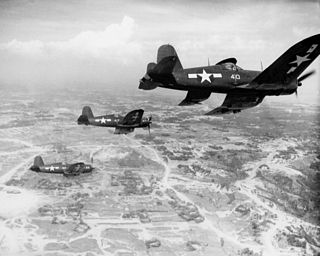
The Tactical Air Force, Tenth Army (TAF) was a joint aviation command of the Tenth United States Army that was responsible for commanding all land-based aviation and aviation command and control units during the Battle of Okinawa. The TAF's headquarters was provided by the 2nd Marine Aircraft Wing and it was the largest joint aviation unit under Marine Corps command during World War II. During the battle, the TAF was commanded by Major General Francis P. Mulcahy until ill-health forced him to be relieved by MajGen Louis E. Woods. According to United States sources, TAF aircraft were responsible for shooting down 637 Japanese aircraft during the battle.
The Marine Air Command and Control System (MACCS) is the aviation command and control agencies of the United States Marine Corps that provide the Aviation Combat Element (ACE) commander with the means to monitor, supervise, and influence aviation operations in support of the Marine Air-Ground Task Force. The command and control agencies of the MACCS are provided by the squadrons and battalions of the Marine Air Control Groups that are present within each Marine Air Wing. The capabilities resident within the MACCS allow the MAGTF commander to safely conduct aviation operations, facilitate timely maneuver and prosecution of fires and ultimately retain full control of their entire area of operations. MACCS agencies are also responsible for coordinating Marine Corps aviation operations with joint, multinational and civil aviation.






















